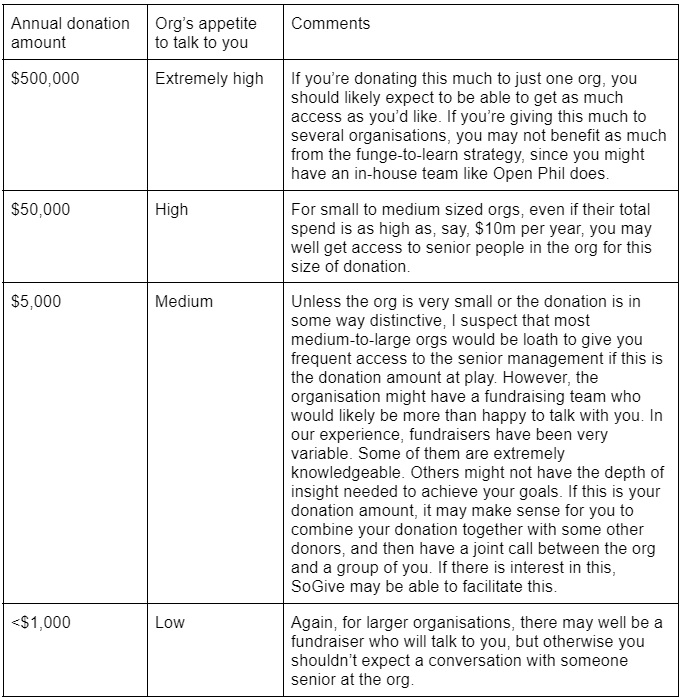Note: I had planned to ask several parties to review this before publishing, however I've just seen the recent discussion about AI safety funding, and this prompted me to publish this sooner than planned. People who would have been asked to comment: people running Open-Phil-funded orgs and contacts at Open Phil. Expect more corrections than usual as a result.
Where a donor wants to support a cause area but is not knowledgeable enough about it, they can use the “coattail-to-learn” and “funge-to-learn” strategies. This involves:
- Picking charities that are already funded by a major funder such as Open Phil
- Maintain a relationship with the recipient for some time (e.g. for a few years), and use that relationship to learn more about their work
- In time, use that knowledge to develop your own thinking on giving
Coattailing or funging against Open Phil allows you to borrow their thinking
If you are an ambitious donor trying to do the most good you can with your money, you may be tempted to find the highest impact donation opportunities on the margin. I.e. your logic might be: “the orgs funded by Open Phil are already adequately funded – I want to find more neglected giving opportunities”.
However:
- Open Phil researches their philanthropy very thoughtfully.
- If you think you can outperform them you should have very strong reasons to believe this.
And where your donation has a funging effect, it’s like you’re playing a big game of whack-a-mole, where the problem of where to have the most impact is whacked away from you and springs up on the Open Phil side of the whack-a-mole gameboard. (This depends on a few assumptions, outlined below).

The problem of finding high impact giving opportunities is a tough one, and giving that problem to Open Phil is a good thing, if you believe Open Phil are good at thinking about and effecting philanthropy. This is an important assumption; assessing it is outside the scope of this post.
The strategy still allows you to be an active donor
If you are a donor who doesn’t want to expend lots of effort thinking about your donations, then you don’t want to be a heavily actively involved donor. You have other options, such as getting philanthropic support from a philanthropic advisor who can do lots of the work for you (full disclosure: we at SoGive offer such a service), or you can donate to EA Funds. This document is not for those donors.
The funge-to-learn and coattail-to-learn strategies are for donors who do want to add their own thoughts and perspectives to their giving process. At first glance, it may seem like the strategy robs you of the opportunity to add your own insights – after all, it’s really Open Philanthropy’s thinking that actually determines where the money goes. In the near term, this is true, but another way of thinking about it is that this strategy still allows you to add your own distinctive thoughts and perspectives, just not hastily.
We at SoGive hold the view that we should not have an ecosystem who all defer to Open Philanthropy or GiveWell. Indeed, we think it’s likely that further scrutiny will highlight areas where those organisations could have done better, and the more that other individuals and organisations are enabled to do this, the better.
But in our view improving the diversity of expert donors does not involve encouraging inexperienced donors to rush in where angels fear to tread.
We believe that the funge-to-learn and coattail-to-learn strategies can help donors on the journey to critically assessing giving decisions made by Open Philanthropy. It involves donors making donations and taking actions, and gradually, thoughtfully forming their own views.
How do you know whether you are a non-expert learner or an expert donor?
If you are already an expert donor, you don’t need to follow a funge-to-learn or coattail-to-learn strategy. How do you know where you are on the scale from non-expert learner or an expert donor?
Some questions which might help you make this assessment:
- How many reports (or documents) have you written which include careful reasoning about the topic? If the answer is zero, it’s highly likely that you are a non-expert. If it’s more than zero, it depends.
- One test is to ask yourself if you can articulate some common failure modes as a donor. The more you struggle with this, the greater the risk that you are prone to those failure modes.
- The threshold you should set depends on the cause area. For example, at time of writing, there’s an upsurge of interest in AI safety.
- If you’ve been in EA for several years, you have probably been thinking about or hearing about AI alignment for a while, whereas your non-EA friends might find these ideas novel. If this describes you, this level of knowledge is not sufficient to make you an expert donor.
- In case of doubt, it’s typically better to err on the side of caution, especially in those areas of longtermist work where donor error leads not just to failing to do good, but to actually making things worse.
Orgs funded by major foundations such as Open Phil often welcome other donors
Orgs funded by (e.g.) Open Phil may welcome other donors for two reasons:
- Their Open Phil funding may not cover their funding needs – if you are filling the gap you are “coattailing to learn”
- Their funding needs may be filled, but they may be keen to diversify their funding sources – if you are providing that diversification you are “funging to learn”
How confident can we be that this would actually ending up funging?
Unlike the coattail-to-learn strategy, the funge-to-learn strategy depends on the whack-a-mole effect working, i.e. that the funding does funge to Open Phil, as opposed to just making the recipient org richer than they need to be.
You can’t be 100% sure that that funging effect will occur. You can choose between “weak funge-to-learn” and “strong funge-to-learn” strategies:
- Under “strong funge-to-learn”, you explain to the org your strategy. You then ask whether they are still willing to receive a donation if it comes with the requirement that when they next request funds from Open Philanthropy (or whoever) the request should be lower to account for the fact the org is receiving funds from you.
- If they realise that the money is simply funging against Open Philanthropy, will they value you less? Probably, but the received wisdom in fundraising circles suggests that (a) you want diversification for risk management reasons (b) your goal as a fundraiser is to build relationships, so even if the donor has the intent to use donations to you as a stepping stone, the relationship is still worth building. Especially if you are a substantial donor, or part of a collaborative group of donors who are collectively substantial. (Note: SoGive is willing to facilitate such collaborations)
- Under weak funge-to-learn, you don’t explain this to your funding recipient, and you don’t include any requirements to adjust the next funding request that they put into Open Philanthropy.
- This may still result in funging, but the funging effect will likely be weak or non-existent.
- Two relevant factors are:
- How large your donation is relative to the org’s total budget. A larger donation is more likely to lead to funging.
- Their reserves policy and how they implement it. Best practice suggests a charity should have an upper limit, i.e. threshold above which they deem themselves to be “too rich”, however several charities don’t have this. Note that even if they have such a policy, and even if your donation is large enough to cause them to hit this limit, the result may be for the charity to set up a new project (rather than return money to Open Philanthropy).
Is talking to leaders of organisations sufficient to learn what you need to be an expert donor?
No. There are other things which you should be doing as well, such as:
- Reading lots of relevant content about cause area
- Reviewing other giving decisions which are in the public domain, e.g. those made by EA Funds, or Open Phil.
- Writing up your thinking on where donations should go.
But having access to people in the relevant organisations certainly helps.
How much should you be donating for this to work?
Crucial to the funge-to-learn strategy is that you are donating enough that the recipient feels it’s worth their time to have a conversation with you. Here’s a rough indication of whether I expect an organisation is willing to have a 1-1 hour-long conversation with you once a year.

How should you be a “well-behaved” funge-to-learn donor?
As a funge-to-learn or coattail-to-learn donor, you are a serious donor, and you should not exhibit the behaviours that sometimes give donors a bad reputation. This is particularly true when the people you are meeting with are the leaders of the organisation you are donating to. Building a relationship with you may be part of their job, but putting lots of effort into educating you shouldn’t be. If the people you’re interacting with are fundraisers, it’s slightly different, but even then it’s possible to place excessive demands on them.
Here is a not-comprehensive list of guidelines for good behaviour:
- Treat the scheduled meeting with the charity as a rare, valuable opportunity to gain access to the time of people doing high impact work, along with the typical markers of respect that come with that.
- If the demands on your time mean that that is difficult, e.g. you risk arriving at meetings late, or are not able to give them your full attention, partnering with SoGive or another philanthropic advice organisation may allow you to have a representative present at your meetings, and who can support you with your thinking as well.
- Often, funders will use conversations with recipient orgs to help them decide whether and to what extent they want to support the organisation. As it happens, talking to an organisation with a view to determining whether to fund them is quite a good way of helping you think about the organisation while engaging your critical faculties.
- If you are not dedicating all your time to your philanthropy, you should expect that you will need some years of learning before you are expert. If you know that this is true, it makes things easier for the organisation if you tell them that you plan to provide them with funding for the next (say) 3 years.
- Note that there is a tension between this guidance and the previous bullet point.
- Some of the advice in earlier sections of this post suggests you should write up your thoughts on effective giving. If you are going to have a conversation with an org and then publish something about them (e.g. on the EA Forum or elsewhere in the public domain) then you should (a) let them know prior to the meeting (b) let them see a draft before you publish.

Personally I think it was a mistake to publish this without speaking with Open Phil. They specifically recommended against what you are suggesting here:
Although we didn't run this post past Open Phil before publishing, we are in touch with Open Phil, and we do ask them for suggestions of places to direct the money we support.
If they were against what is being outlined here, I think they would have said so when we've been in touch with them. Instead they were helpful.
If anyone is interested in joining a coattailing/funging-to-learn group, feel free to drop me a note via private message on the EA Forum, or email me on sanjay [at] sogive.org